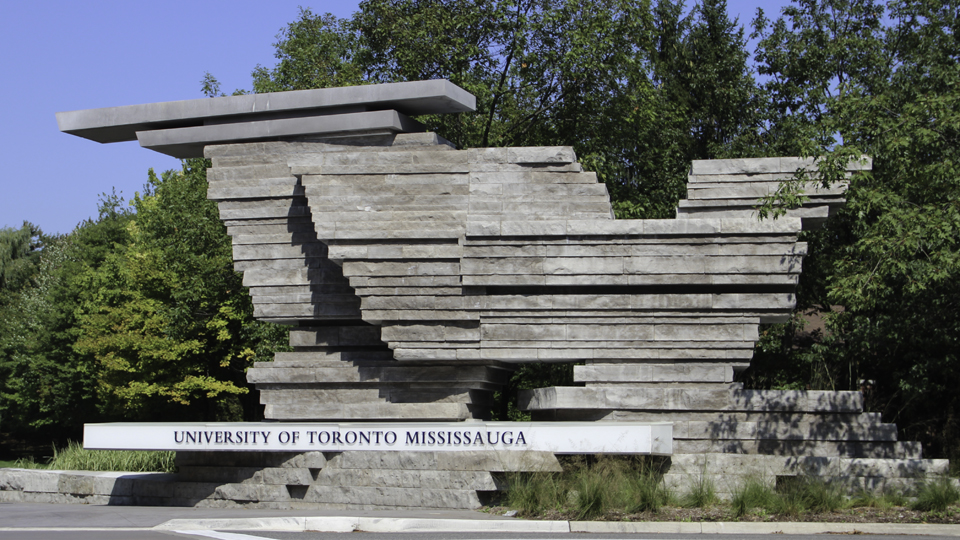A new sign built for UTM’s Middle Entrance as part of administrative plans to refurbish UTM’s three entrances has generated overwhelmingly negative student feedback.
In April 2011, architects were invited to submit preliminary ideas for a redesigned entrance to create a “substantial sense of presence at [the] front door to our campus,” according to Paul Donoghue, UTM’s chief administrative officer. “To suggest the old Erindale College sign was low-key would be an understatement.”
In August and September of that year, a focus group of faculty, staff, and alumni worked with architect Jonathan Kearns of Kearns Mancini Architects in Toronto to work through various iterations of the design, the final result being one that Donoghue felt “captured perfectly what [they] were trying to achieve”. Construction of the new entrance started in March 2012.
The sign is made of Credit Valley stone, a selection that speaks to the history of the campus’s natural setting. The entrance also harks back to the founders of Erindale College, especially its second principal, John Tuzo Wilson, an internationally acclaimed geophysicist and geologist who advanced plate tectonics theory and first described the concept of a transform fault.
Donoghue revealed that the total project cost was $998,000.
The UTM Students’ Union posted a photo of the new Middle Entrance on their Facebook page on April 4, challenging students to guess the cost. The post has received over 250 comments and 80 shares to date, as well as 23,000 views, reported UTMSU’s president, Raymond Noronha.
The response from students was almost universally negative, deploring what was seen as an excessive cost and listing other possible uses of the funds, including expanding spaces to keep up with the demand of enrolment and slowing tuition increases.
“The fact that University of Toronto, a public institution, splurged $1 million on a vanity project is rather outrageous,” said Ju Li, a fourth-year math and economics student, in an interview.
Consensus was also reached unequivocally that the sign’s appearance was unattractive.
Not all student feedback was critical of the bodies that approved the sign, however.
Christopher Fletcher, a fourth-year CCIT student, suggested that its purpose was to direct guests and prospective students in and ultimately increase enrolment. “Without something iconic like a sign, some people will never even know that this school exists,” he said.
Other students pointed out that the publicity from UTMSU came long after the project’s approval and the beginning of construction.
Faris Natour, a fourth-year commerce student, agrees that the expenditure “does not directly benefit students”, but holds the union accountable for failing to lobby against it.
“UTMSU have failed in their job to, at the very least, educate us about the statue and its costs,” he said in an interview. “Don’t they attend Campus Affairs Committee meetings that are supposedly involved in the planning of such projects?”
When asked why UTMSU was unaware of plans to reconstruct the main entrance until after construction began, Noronha replied, “UTMSU was not notified by the university regarding the campus’s Middle Entrance project.”
According to Noronha, last year’s president, Christopher Thompson, repeatedly asked for the cost of construction at the last meeting of the now-dissolved Erindale College Council on April 4.
When his questions went unanswered, said Noronha, UTMSU’s VP part-time affairs Sabiha Sumra requested that the chair of ECC ask Donoghue answer. Donoghue confirmed that the total project cost was approximately $1 million.
“The reaction from the student representatives and faculty was […] shocking,” said Noronha. “Professor Judith Poe shared her concern about the lack of adequate resources invested by the university to enhance the academic experience of students in the classrooms, such as better lab equipment.”
Noronha said that UTMSU was unable to lobby against the project because the details were “very secretive”.
Explicit mention of the sign is made in ECC minutes from at least as long ago as October 2012.
Projects that cost less than $3 million are not subject to the same process as capital projects, which are guided by a project committee with prescribed membership that includes faculty, staff, and undergraduate and graduate students before the project is routed through the university’s governance process.
The Middle Entrance project and other projects costing less than $3 million (of which there are typically 30 to 40 going on at any given time at UTM) are instead routed through UTM’s Space Planning and Management Committee for review and approval. The Middle Entrance project was approved by SPMC on April 22, 2012.
There is one spot on the SPMC allotted to student representation; according to Noronha, the administration did not fill this reserved spot with a student.
“Hence, no student was consulted on the project at any moment since its launch,” said Noronha. “UTMSU requested for formal representation on that committee. The University administration rejected that request. UTMSU does not consider [the SPMC] process transparent and made a formal request for a revision on these practices.”


Sep 16, 2013 @ 18:07:00
I like the sign… makes me feel like I go to an important institution whenever I enter through that entrance. The costs, however, were very large. I’m sure they could have made some concessions to cost.
Apr 29, 2014 @ 14:56:00
The sign is hollow too.
Sep 16, 2013 @ 15:46:00
“The Middle Entrance project and other projects costing less than $3 million (of which there are typically 30 to 40 going on at any given time at UTM) are instead routed through UTM’s Space Planning and Management Committee for review and approval. ”
Can you please expand on these ’30 to 40 projects’ going on?
Sincerely,
Concerned
Sep 24, 2013 @ 20:58:00
I think it could be something as simple as planting trees and whatnot. You know, usual groundwork.